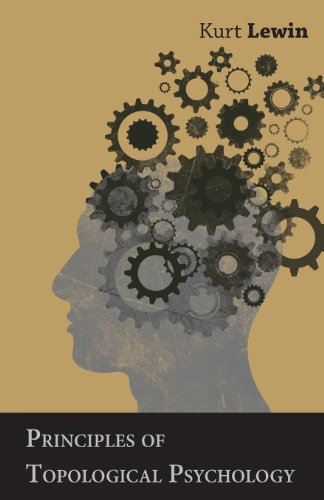Principles of Topological Psychology

On the surface, it would seem like math would have very little to do with psychology. However, when looking at Kurt Lewin’s work in Principles of Topological Psychology, it’s clear to see how mathematical models influenced his thinking on psychology and how to motivate people.
Context and Math
Most folks know Kurt Lewin’s work because of his famous equation that behavior is a function of both person and environment. Some are aware that he proposed a model for change that involves unfreezing behavior, changing behavior, and freezing it again. Those aware of his concepts regarding force fields and their application in accomplishing change will recognize how Lewin was influenced by science and electromagnetism. (See A Dynamic Theory of Personality for more.)
Here, Lewin’s thoughts about psychology and motivation use set-based language from advanced math. He speaks about the things that are inclusive to a state, the boundary conditions, and other concepts that are borrowed directly from advanced mathematics.
I was surprised about the relationship, even though I had read John Gottman’s work in The Science of Trust. Gottman’s particular interest in game theory comes from advanced mathematics and mathematical simulation as well. If you want to know more about game theory and its application, see The Evolution of Cooperation.
States and Motion
While force field analysis was concerned with the motivators for moving someone in one direction or another, topological psychology is concerned with your current state and the places that are accessible from that state. It’s about creating a map from where someone is at any given moment to their desired state. The transition from today to the future can be a single step across a single border or it can be a multi-step process with various borders.
The motive force is provided by force fields pushing or pulling on the psyche of the individual, but the application of that force is most interesting in topological psychology. What path will be chosen to move towards the goal – and why?
Relationships
One of the key points is that it’s more than the force that’s applied to a person. It’s the relationship between the person and their environment – or the mental maps of their environment – that really matter. Relationships have multiple meanings when addressing psychology. Here, the relationships are most concerned about the interaction of the person with the environment. The environment pulls on the person, and the person pulls on the environment.
While it’s helpful to think of one force that drives someone and one set of conceptions of the environment that drive the behavior in one direction or another, it’s more accurate to say that there are many forces and understandings of the environment that shape the way the person will behave.
Regions and Boundaries
Regions are the collection of mental states that are qualitatively like one another – and other regions are qualitatively different. Boundaries are the places between these two dissimilar spaces. There are two implications from math that are useful but not infinitely true.
First, regions can be subdivided. Just because the region contains a set of mental states that are similar doesn’t meant that, when evaluated from another dimension, the region might not split into two regions. Mathematically, a closed set should allow for infinite subdivision. While this is unlikely the case with mental states, it’s possible to provide a great deal of division, thereby separating thoughts and perspectives based on numerous criteria.
Second, boundaries are really regions as well. While it’s easy to conceptualize a boundary as a crisp line, such a crisp distinction doesn’t always exist. Consider the regions for the colors red, blue, and green. In which group does the color blue-green belong? This classic information architecture problem leads to an awareness that even boundaries can be expanded to more detail when appropriate.
Person and Environment are not Independent Variables
Going back to Lewin’s equation that behavior is a function of both person and environment, it’s important to recognize that the person and the environment are not independent variables. That is, person impacts environment and environment impacts person. While we can recognize the distinct agency of the person, we should acknowledge that a person is – at least partially – a product of their environment. (See No Two Alike for more.)
If you’re wondering how people move from one perspective to another – and how that impacts behavior – maybe it’s time to look at the Principles of Topological Psychology.
